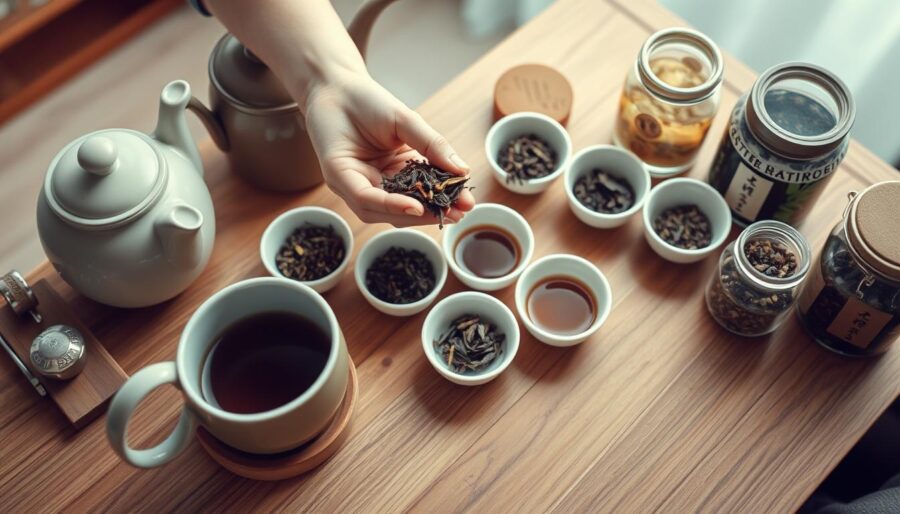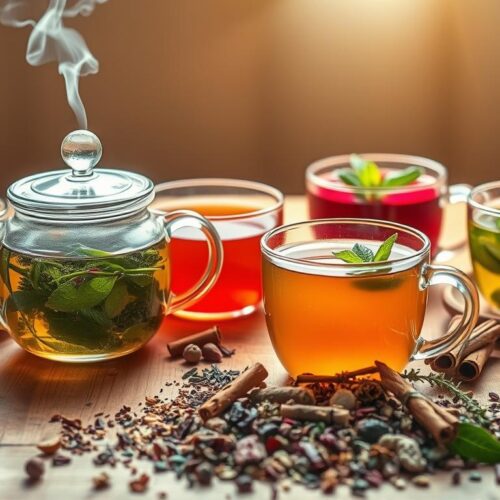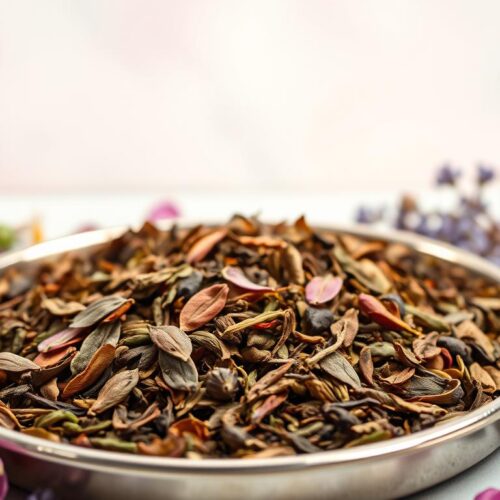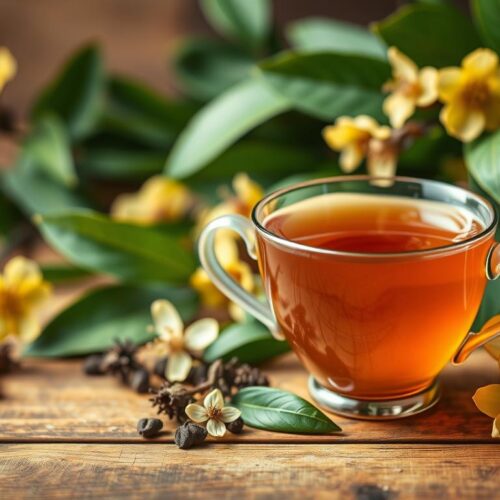Learning to taste tea is about more than guessing. This book combines science with tradition, helping you improve your tea tasting skills. Over time, you’ll link tea’s flavors with what you smell and taste. Your aim? To get clear tea tasting notes you can count on.
Bob Holmes in Flavor says genetics affect our taste by 20%. The rest is up to practice, focus, and setting. That means anyone can get better at tea tasting. By regularly tasting tea, you’ll figure out the five basic tastes. Plus, you’ll explore tea’s aroma, how it feels in your mouth, and how the flavor changes.
Experts use certain tools like tasting grids and flavor wheels. You’ll learn from these and also embrace gongfu tea time to enhance focus. Reading works like Taste by Barb Stuckey and Cork Dork by Bianca Bosker tells us that structured practice is key. Short, dedicated practice sessions help sharpen your tasting skills.
The setting is key when tasting tea. Different regions give tea unique qualities. For example, Darjeeling introduces high-altitude flavors, while Assam reveals a tropical richness. During practice, you’ll slurp tea to mix it with air, compare brews, cleanse your taste, and jot down detailed notes about each tea’s aroma and finish.
Next up, a guide to refining your taste and clarifying your thoughts. You’ll gain a common language for discussing tea, learn consistent tasting techniques, and interpret tea aromas accurately. Eventually, your tea notes will be detailed, consistent, and helpful, whether you’re at home or judging teas professionally.
Understanding Tea Basics
Learning how to taste tea starts with knowing what to look for. First, check the dry leaves for their shape and color. Then, see if the wet leaves are still whole and even. Look at the color of the tea in your cup. Next, smell the dry leaves and the steam. Taste for sweetness, bitterness, and other flavors for balance. Last, feel the texture in your mouth and notice the aftertaste. These steps help you understand tea more clearly.
Where a tea comes from affects its taste. The tea leaf shows its environment like elevation and rainfall. Also, how it’s made plays a role like when it’s picked. In China, people care about where their tea is from. You can taste the difference in teas from different places because of the soil and the tea maker. Linking tea to its place helps you appreciate it more and learn about different tea types.
Height and weather change how tea tastes. Tea from high up like Darjeeling has strong smells. In hot places, tea has more body, like Assam black tea. Right amount of rain makes oolong teas from Fujian just right. Humid places are good for white teas from Fuding. Cool weather makes Uji green teas fresh. Dry seasons are best for aging Yunnan pu‑erh teas.
Using a tea flavor wheel helps you name tea tastes. You can find vegetal, fruity, and other flavors. This tool helps you talk about tea clearly and remember tastes better.
| Aspect | What You Check | Why It Matters | Real-World Examples |
|---|---|---|---|
| Appearance | Dry/wet leaf integrity, uniformity; liquor color | Signals plucking standard and processing precision | Whole buds in Silver Needle; tight strips in Longjing |
| Aroma | Dry-leaf scent and rising steam from the cup | Reveals terroir and crafting choices | Rocky-mineral nose in Wuyi oolong; floral Darjeeling |
| Taste | Sweetness, bitterness, astringency, umami, balance | Defines structure and harmony in the sip | Honeyed body in Assam; chestnut note in Longjing |
| Mouthfeel | Body, creaminess, tactile astringency | Shapes comfort and perceived quality | Silky Tieguanyin; brisk Ceylon from Dilmah |
| Aftertaste | Length and evolution after you swallow | Shows depth and leaf vitality | Lingering camphor in aged pu‑erh by Dayi |
| Terroir Cues | Elevation, rainfall, soil, flora, seasonal timing | Predicts core tea characteristics and style | Uji shade-grown sencha; Fujian white tea in humid springs |
| Flavor Mapping | Use a tea flavor wheel to tag key notes | Improves recall and objective comparison | Vegetal, fruity, berry, spice, savory, malty, woody |
Tasting tea is unique to each person. Your biology, age, and experience shape how you taste. Everyone’s tea map is different, and that’s a good thing. It makes your tea tasting skills stronger over time.
The Importance of Tasting Notes
Tasting notes make a quick sip into a lasting memory. They help you remember and find patterns in different teas. This way, you can easily compare teas from places like Darjeeling and Longjing.
When tasting tea, you write down things like the look, smell, taste, and feel. You also note details such as where it’s from, the season, and how it was made. Keep your notes simple to help remember better.
Visual aids can help you remember your tea experience. You could draw a timeline or shapes that show the tea’s texture. Studies say these aids help you go from a casual tea drinker to an expert.
Start by using basic words for flavors and refine them over time. For green teas, words like grassy or spinach are good. For fruit flavors, think of apple or peach. And for deeper tastes, malt or cacao work well.
Good tea notes help with checking quality, choosing blends, and talking to customers. Big tea companies use detailed notes to keep their teas consistent. They also help customers pick the best tea for their taste.
| Aspect | What to Observe | How to Record | Example Flavor Descriptors |
|---|---|---|---|
| Leaves | Shape, size, integrity, aroma off the dry leaf | Short phrases; note uniformity and any defects | Toasty, grassy, floral |
| Liquor Color | Hue and clarity in the cup | Hex words or plain color terms for contrast | Pale jade, amber, copper |
| Aroma | Top, middle, base notes as heat rises | List in order of arrival with timing cues | Citrus zest, honey, malt |
| Taste Balance | Sweetness, acidity, bitterness, umami | Rate light/medium/high; add context | Peach sweetness, cocoa bitterness |
| Mouthfeel | Body, texture, astringency level | Single adjectives and a 1–5 scale | Silky, creamy, gripping |
| Aftertaste | Length and shift of flavors after the sip | Seconds counted; note final impression | Long mineral finish, ginger warmth |
| Context | Origin, garden, season, altitude, processing | Concise facts to tie to future brews | First flush, spring, hand-fired wok |
| Vocabulary | Shared terms for clarity | Keep a living glossary you update | Spinach, asparagus, blackberry, saffron |
Preparing for a Tasting Session
Before you start, set your intentions. Pick a calm time when you don’t need caffeine or hydration. Make sure to turn off any distractions. This helps focus your tea tasting session and allows you to notice the tea’s subtle flavors.
Get a clean space ready just for tea tasting. You’ll need a gaiwan or a small teapot, a kettle, a timer, and good lighting. Choose a spot where you can concentrate for an hour. Spread out the dry leaves to see their texture—whether they’re downy buds, flat-pressed greens, or compressed pu‑erh. Imagine where they’re from and how they were made.
Set up a tea cupping kit for consistent results. Using porcelain bowls, lidded cups, and a tasting spoon makes it easier to compare different infusions. Make sure to follow the ISO 3103 standards for the amount of leaf to water, water temperature, and steeping time. It’s also good to have a white or neutral background to better see the tea’s color and clarity.
It’s key to keep all your tools clean to prevent mixing flavors. Be ready with a thermometer and a digital scale. Keep water and plain bread close to clean your palate between tastings. Have tasting sheets ready to note down your experiences in an organized way.
After the first wash or infusion, open the lid and take in the scent of the wet leaves. This primes your taste buds and brings out initial flavors like floral, malt, or stone fruit. Remember what you notice to keep your tasting focused on each steep.
- Teaware: gaiwan or teapot, porcelain cupping set, tasting spoon
- Precision: thermometer, digital scale, timer
- Environment: clean surface, quiet room, neutral light
- Support: water, neutral bread, tasting sheets
Follow the same steps for each tea tasting. By setting up carefully and focusing on the process, you’ll be able to notice even the smallest changes in flavor with each steep.
Developing Your Sensory Skills
Begin your sensory journey by smelling more and talking less. Let the scent of tea gently rise as you sip quietly. Take a moment to breathe it in, then pause. Notice your initial feelings without trying to name them. This helps you learn to taste tea slowly, not in a rush.
Improve your smell sense with simple daily practices. Explore different scent groups like fragrant, woody, fruity (but not citrus), chemical, minty, sweet, popcorn, lemon, pungent, and decayed. Keep this scent list nearby when tasting tea. Compare your feelings to these familiar smells.
Create blind-smell tests using spices from your kitchen—like cinnamon, clove, star anise, black pepper, cacao, and dried orange peel. Use brands such as McCormick or Simply Organic. Mix them up, sniff, and try to recognize each spice. Remember, getting better takes time. Even experts don’t catch every scent. Focus on clear notes over recognizing many smells.
When drinking tea, slurp it to let air mix with the tea. This trick helps release more scent. It enhances the tea’s aroma, making each taste clear and distinct.
Learn about texture and how the tea feels in your mouth with slow moves. Feel whether it’s creamy, has a fizzy touch, or leaves your mouth dry. Think of it like touching old books, leather, linen, stone, or wood. This will help you remember and describe tea’s taste better later on.
Try to be unbiased in your taste tests. Skip judging if you like it or not at first. Focus on the scent, taste, and texture instead. Then connect each to why you feel that way. Mini tests with two teas alike and one different, from brands like Harney & Sons or Rishi, are good. They improve your ability to notice even small changes.
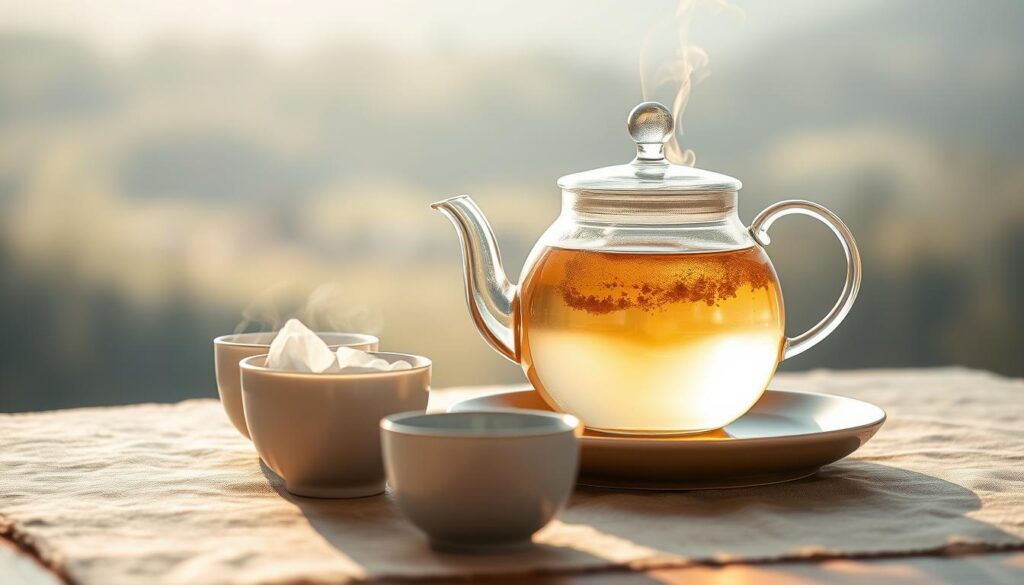
Keep practice sessions short and do them often. Change up the scents, water types, and retry the same teas on different days. As research by Bob Holmes shows, you can train your senses with time. Regular practice sharpens your tea tasting skills. Your descriptions become more accurate, and your understanding of tea’s tastes broadens easily.
| Drill | Goal | Method | What to Record in Tea Notes |
|---|---|---|---|
| Odor Family Walkthrough | Expand smell vocabulary | Sniff through fragrant, woody/resinous, fruity (non-citrus), chemical, minty, sweet, popcorn, lemon, pungent, decayed | Top three matches, intensity 1–5, confidence level |
| Blind-Spice Jars | Sharpen identification | Label bottoms, randomize, sniff, reveal | Correct IDs, frequent confusions, descriptive cues |
| Slurp and Swish | Enhance retronasal perception | Aerate sip, spread across palate, exhale through nose | Tea aroma shift before/after slurp, volatile notes detected |
| Mouthfeel Mapping | Train texture awareness | Time the finish, note drying, weight, and lift | Creamy vs. lean, astringency level, tactile metaphors |
| Triangle Test | Discriminate small differences | Two identical teas, one different; pick the odd cup | Which is different, why, and strength of evidence |
Identifying Flavor Profiles
Start with a tea flavor wheel to guide you. Begin with broad flavor profiles and refine them into precise tea notes. Move from vegetal to fruity, then to berry, spice, savory, and woody tones. Always match your tastes to vivid, real-life examples. Remember, it’s important to pay attention to balance, how the tea feels in your mouth, and the aftertaste. The whole experience matters, not just the first taste.
First, explore vegetal flavors like fresh-cut grass, spinach, and asparagus. These often describe green teas from Uji, where cool shade boosts their chlorophyll. Next, look for fruity notes. You might find the crispness of apple, the juiciness of peach, the brightness of citrus, and the sweetness of banana in some Taiwanese oolongs. Berries might taste tart like hibiscus or deep like blackberry and elderberry. These are typical in Wuyi rock oolongs, such as Da Hong Pao, which also have a mineral flair.
Then, dive into spicy flavors like cinnamon, ginger, and peppercorn. These are common in many black teas from Assam. Assam’s tropical climate contributes to a full body and malty taste. Next, consider savory and malty nuances. Think about the flavors of saffron, raw cacao, semolina, and warm malt. For woody and earthy notes, look for cedar and the aging process of pu-erh teas from Yunnan. These teas develop complex layers over time with seasonal dryness.
Avoid sticking to stereotypes about tea. Many green teas are vegetal, but some can be lightly fruity. Oolongs mix fruit and floral notes; Wuyi varieties add dark berry and mineral tastes. Black teas often have malty and spicy flavors, whereas white teas offer gentle sweetness and a silky feel. Teas from high places like Darjeeling boast aromatic qualities and structured finishes. Each type of tea has unique characteristics that shape its taste.
Use an analytical grid to record your tea tasting notes. Note the aroma, the initial taste, the flavor in the middle, texture, and the final aftertaste. Compare your observations with the tea flavor wheel for accuracy. As you get better, your notes will consistently highlight each tea’s unique features. This will boost your confidence in identifying each cup.
Taking Tasting Notes
Create a consistent log for your tea tasting notes to keep them organized. Include the tea’s origin, like its garden or region, and the elevation if you know it. Also, jot down the season it was picked. Add details about the style and how it was processed, for example, if it’s steamed sencha, pan-fired longjing, or charcoal-roasted oolong. Write down how you brewed the tea—like the amount of leaves, water temperature, brewing time, and what vessel you used. This helps you remember exactly how to make that tea taste perfect again.
Note everything about your surroundings when tasting. Mention the water you used and its quality, the room’s humidity, and how much light there was. Write about what the dry leaves look like and what they smell like. After brewing, see how the color of the tea looks against a white background. Examine the wet leaves to check their quality. Describe the tea’s smell in three parts: the top, middle, and base notes.
When you taste the tea, slurp it to let air mix with the tea. Note how sweet, bitter, sour, flavorful (umami), and drying (astringent) it is. Look for how these tastes balance each other out and how complex the flavor is. Describe how the tea feels in your mouth—is it light, rich, or somewhere in between? Does it feel creamy, make your mouth dry, or is it fizzy? Say how long the taste stays in your mouth and if it changes. Use simple, clear words to keep your notes direct.
Consider using a simple chart or a timeline to mark the tea’s flavors over time. Studies show that timelines help us remember better and match how experts think. In between tasting different teas, cleanse your taste buds with water or plain bread. This keeps the flavors from mixing up in your notes.
Try comparing teas directly by tasting them next to each other or using a triangle test. This can help you spot minor differences, like how the roast affects the flavor, the size of the leaves, or changes in water temperature. End with a short overview of each tea. Talk about its main flavors, any unique characteristics, and how best to enjoy it—by itself, mixed with other teas, or with food. This helps you make good choices when buying tea and when sharing your recommendations.
| Category | What to Record | Example Entry | Why It Matters |
|---|---|---|---|
| Identity | Origin, garden/region, elevation, season, style/processing | Darjeeling, Goomtee, 1,500 m, First Flush, light oxidation | Context for provenance and expected tea notes |
| Brewing | Leaf ratio, water temperature, time, vessel | 3 g/150 ml, 185°F, 2:00, porcelain gaiwan | Replicates how to taste tea across sessions |
| Environment | Water quality, ambient humidity/light | Filtered NYC tap, low humidity, natural light | Controls variables that shift tea tasting |
| Visuals | Dry-leaf color/shape; liquor color on white; wet-leaf integrity | Olive, flat spear leaves; pale jade liquor; bright, whole buds | Correlates processing and freshness with cup quality |
| Aroma Layers | Top, middle, base | Top: jasmine; Middle: pear, oat; Base: wet stone | Structured mapping for consistent tea tasting notes |
| Taste & Feel | Sweetness, bitterness, acidity, umami, astringency, mouthfeel | Sweet early, mild bitterness, low acidity, silky medium body | Defines balance and complexity on a tasting grid |
| Aftertaste | Length, evolution | Medium length; floral turns to almond | Signals quality and brewing accuracy |
| Comparisons | Side-by-side or triangle test notes | Hotter brew adds grip; cooler brew shows more citrus | Reveals parameter sensitivity for how to taste tea |
| Synthesis | Core character, standout notes, ideal use | Bright, floral; jasmine and pear; best solo or with goat cheese | Transforms data into clear guidance for tea tasting |
Understanding Aroma
Tea aroma adds a lot to what we consider flavor when tasting tea. Start by smelling the dry leaves, then the wet leaves after their first rinse or infusion. Open a porcelain gaiwan or teapot and take deep, focused breaths. This process lets you predict the taste and shape your tea notes.
Check the aroma of the tea right after you pour it, and again as it cools down. Identify the initial, body, and lingering notes. Slurping gently helps spread the aroma to your nose, enhancing the flavor you sense.
Learning about different smells helps you talk about them better. Use terms like woody, fruity, minty, or citrus to describe them. By adding specific terms like grassy or floral, you make your tea tasting notes clearer.
People have about 350 smell receptors, and we all sense smells in unique ways. In group tea tastings or classes by brands like Twinings or Harney & Sons, participants often have different impressions. These differences give valuable insights.
Keep your tea tools clean and scent-free. Porcelain is great because it doesn’t hold onto flavors. Rinse with hot water, skip the scented soap, and let them dry in a clean area before smelling again.
Pay attention and breathe calmly to catch small changes from hot to cool tea. Write down what you notice every 30 seconds. With practice, you’ll connect smells to memories, helping you recognize tea patterns from various places and times.
| Stage | What to Smell | Common Tea Notes | Technique Tip | Why It Matters |
|---|---|---|---|---|
| Dry Leaf | Volatile oils on the surface | Grassy, floral, malt | Warm the tin lightly in your hands | Sets a baseline for tea aroma before water alters it |
| Wet Leaf (Post-Rinse) | Concentrated steam from opened lid | Stone fruit, dark berry, woody/resinous | Open the gaiwan and inhale in short pulses | Reliable preview of taste during aroma evaluation |
| Hot Cup | Top notes in rising vapor | Lemon/citrus, minty, fragrant | Slurp to drive retronasal flow | Captures lift and clarity in early tea tasting sips |
| Cooling Cup | Middle and base notes as intensity settles | Spice, earthy, sweet | Wait 60–120 seconds, then compare | Reveals depth and finish for precise tea notes |
| Empty Cup | Residual film on porcelain | Caramel, malt, popcorn | Smell the cup walls after sipping | Highlights lingering compounds after evaporation |
- Anchor categories first, then refine descriptors for consistent smell training.
- Use clean porcelain and unscented water to keep the tea aroma accurate.
- Record top, middle, and base notes to stabilize your aroma evaluation across sessions.
The Role of Temperature and Time
Temperature and time really set the stage for tasting tea. They help you control what flavors you get. It’s like a science experiment where everything must be precise. You follow a set recipe or guidelines like ISO 3103. This way, your tea tasting is fair and you can really compare. Let your tea cool a bit before trying it so you can really catch all the smells and reduce the impact of the heat.
Heat can change how your tea tastes. Cooler water keeps the fresh, lively taste in Japanese sencha and lessens bitterness in Dragon Well tea. Warmer water brings out the richness and spice in Assam tea and some oolongs. The length of time you let it steep affects the flavor too. Short times make it light and floral, while longer times make it stronger and more tannic.
Keep track of how you make your tea each time. Write down the kind of water, the room’s humidity, and even the light. They all affect how your tea tastes. Taste your tea in a quiet place, and try it again as it cools down. Use the same kind of cups or pots, from brands like Hario or Loveramics, to make your tests more reliable.
Try making tea in several rounds to see how its flavor changes. With gongfu-style tea making, you’ll notice changes in the feel and taste of the tea. Note down every detail of each round, like any tiny changes in how long you steep it. This practice makes you better at tasting tea. You’ll be able to repeat your tea making more consistently, following ISO 3103 methods.
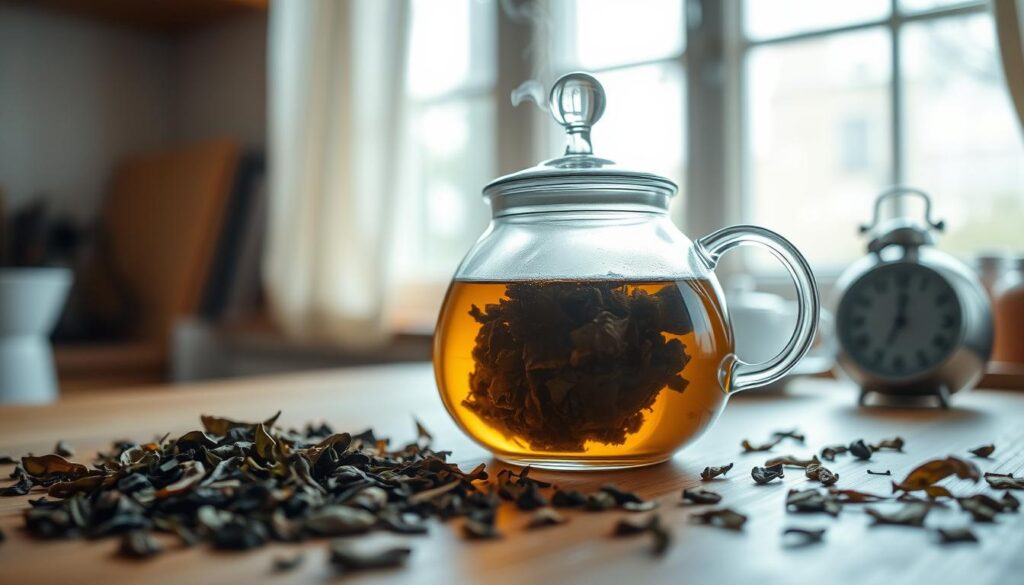
- Greens: cooler water, shorter time for lift and clarity.
- Blacks: hotter water, moderate time for body and spice.
- Oolongs: start hot, adjust time across infusions to follow texture.
- Whites: medium heat, longer time for honeyed depth without bite.
Keep a journal of every detail: dose, grind (for broken leaves), pot, and how you brew. Note when you first smell something, when it gets sharp, and how the sweetness sticks around. Follow the same steps every time you taste tea. This helps you build useful notes that you can look back on.
Engaging with Tea Communities
Practicing tea tasting with others can help you grow. When you share sessions, you can compare what you think tastes like apple to what someone else thinks tastes like orange. This helps you understand tea better. Always keep an open mind with your tea notes and share what you think with others.
Find tea communities at local stores like David’s Tea or TeaGschwendner. Attend cuppings that are similar to those for coffee and wine. People use tools like aroma wheels and tasting language prompts. This helps train your senses.
Experts talk about tea grading and the market. This shows how sensory experiences turn into labels we see on products from brands like Harney & Sons and Twinings. Listening helps you understand how clear tasting notes lead to reliable quality. Write down any useful phrases you hear.
Doing group activities helps everyone get better. Try different tests like comparing teas or timing how long they steep. You’ll notice changes in taste. Learning from others, remember to stay calm and respectful, following Chinese tea culture. Here, the goal is to learn together.
- Before the meet-up: choose one tea style and agree on water specs.
- During tasting: speak in simple tasting language, then add precise tea characteristics.
- Afterward: merge group insights into your tea notes and tag patterns.
| Exercise | Goal | What to Track | How It Improves Your Palate |
|---|---|---|---|
| Triangle Test | Spot the odd cup among three | Aroma cues, finish length, body | Sharpens focus on subtle tea characteristics |
| Blind Flight | Rank samples without labels | Clarity of tasting language, consistency | Reduces bias and strengthens comparative tea tasting |
| Aroma Wheel Drill | Expand descriptors | Specific tea notes across layers | Builds a shared vocabulary in tea communities |
| Timed Steeps | Assess impact of extraction | Bitterness, sweetness, texture | Links brewing to measurable tea characteristics |
Experimenting with Food Pairings
Start your tea tasting by taking notes on the tea alone. This prevents carryover bias from the food. Use the tea flavor wheel to find tea traits like grassy, floral, malty, or mineral. Then, try matching them with small bites of food to see what complements or contrasts work best.
Greens that taste grassy or like spinach go well with light, green dishes like steamed asparagus or cucumber salad. Oolongs with hints of peach or citrus can enhance stone fruit desserts and lightly spiced foods. Dark-berry and mineral-rich Wuyi oolongs, like Big Red Robe, pair nicely with roasted mushrooms.
For malty, spicy teas from Assam or Sri Lanka, choose sweets with cacao or savory, peppered dishes. Delicate white teas go well with soft textures like ricotta, panna cotta, or fresh mozzarella. How a tea feels in your mouth is key: creamy teas match dairy, while brisk, astringent teas cut through fatty foods.
When sequencing, sip tea first, then try food, and then go back to the tea. Clean your palate with water or plain crackers in between. Notice how the aftertaste changes with different foods; sweetness or minerality can make flavors stronger, changing how you perceive the tea.
Keep your tasting notes personal and exploratory. If you taste apple where someone else tastes orange, write it down. Your observations are clues, not strict rules. Over time, your notes will reveal patterns that improve your skill in pairing tea and food.
| Tea Style | Key Tea Characteristics | Suggested Food Pairing | Tasting Focus |
|---|---|---|---|
| Japanese Sencha | Grassy, umami, brisk | Steamed greens, sushi rice, cucumber | Cutting fat, enhancing umami |
| Tieguanyin Oolong | Floral, peachy, creamy | Stone fruit tart, mild curry | Echo sweetness, soften spice |
| Wuyi Big Red Robe | Dark-berry, mineral, roasted | Roasted mushrooms, charred eggplant | Match roast, extend minerality |
| Assam Black | Malty, bold, spicy | 85% dark chocolate, peppered steak | Balance cacao bitterness, cut fat |
| Silver Needle | Delicate, honeyed, silky | Ricotta, panna cotta, poached pear | Preserve subtlety, echo cream |
Refining Your Palate Over Time
Think of palate training as a relaxed, ongoing practice. Have regular “free time tea” sessions to learn focused tasting. Keep a notebook for your tasting notes to see your progress, without aiming for perfection.
Change your study topic weekly. One week, sort teas by aroma: floral, fruity, roasted, earthy. The following week, focus on how the tea feels in your mouth—silky, dry, oily, brisk. Then, note the length of the aftertaste and the flavor that lingers. This method makes your tea tasting precise and consistent.
Sharpen your senses with mini tests. Brew two small cups at different strengths and compare them, including a control cup. Daily, practice smelling things like lemon zest and cinnamon. Improvement is gradual. Remember, even experts have limits with complex teas, so aim for clear understanding over guessing.
In your notes, track how strong the flavors are over time. Use colors to mark the high points of aroma and the finish. Studies from Harvard and Cornell show using pictures helps memory. This will make recalling flavors easier because your notes tell a story.
Focus objectively during your sessions. Question what you’re tasting and why, instead of if you like it. This approach broadens your palate, letting you enjoy a variety of teas, from light Longjing to strong Assam, from brands like Twinings and Harney & Sons. Try the same tea in different seasons to see changes in flavor and structure.
Learn with others. Attend local tastings or discuss with tea clubs. Your tasting skills improve when you compare your opinions in a group, especially when trying a range of teas together.
| Practice Focus | Method | What to Record | Benefit to Palate |
|---|---|---|---|
| Aroma Mapping | Short sniffs before and after first sip | Tea aroma categories and intensity (0–5) | Builds scent vocabulary for tea tasting |
| Mouthfeel Drill | Compare two steeps at different ratios | Viscosity, astringency, temperature comfort | Separates texture from flavor in tea tasting notes |
| Aftertaste Clock | Time the finish with a stopwatch | Duration, flavor shift, retronasal cues | Trains how to taste tea over minutes, not seconds |
| Triangle Test | Two identical, one different; blind pick the odd cup | Success rate and reason for choice | Sharpens discrimination and reduces bias |
| Daily Smell Reps | 5 scents from kitchen spices and fruits | Name, memory link, confusion pairs | Strengthens aroma recall for faster ID |
| Seasonal Revisit | Same tea across weather changes | Body, balance, brew adjustments | Reveals environment’s impact on how to taste tea |
Bringing It All Together
Start by organizing your workflow: prepare, perceive, and document. Make sure your space is quiet and tidy. Use a porcelain cupping set or a gaiwan, and a sturdy teapot. Stick to precise temperatures and timings, based on ISO 3103 or the producer’s advice. Look at the tea color against a plain background. It helps you focus on the tea’s true color and qualities, making your tea tasting consistent each time.
Then, examine the cup carefully. Look at the dry and wet leaves and smell them in steps. When you sip, do it in a way that mixes air with the tea. This process helps you notice the taste, feel, and lingering flavor of the tea, especially through several infusions. Recognize the unique hints that each origin offers: Darjeeling for its high-mountain freshness, Assam for its robust depth, Uji for its crisp greenness, Fujian for its fine balance, and Yunnan for its rich complexity. This approach adds meaningful background to tasting, beyond just the taste itself.
Write down your observations in detailed tea tasting notes. Describe using a tea flavor wheel to keep your words consistent and clear. Note down your timing, the tea’s origin, the season, water quality, and even the weather. Keep your notes short but descriptive, like “honeyed malt, brisk finish, cool mint afterfeel.” These records will help you understand your taste preferences better and improve your ability to judge tea.
Practice regularly but in manageable sessions. Try brief daily tastings, comparison tests, and use neutral palate cleansers such as room-temperature water or plain crackers. Participate in group tastings now and then to broaden your vocabulary and minimize your personal bias. Approach this practice with a thoughtful balance of art and science, respecting the traditions of Chinese tea culture. By continuously practicing, your ability to taste and document tea will become effortless. Your notes will guide you in buying, pairing, and sharing tea—making every cup you drink or serve even better.

